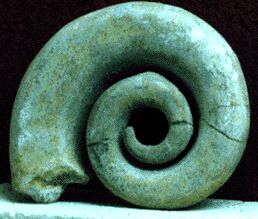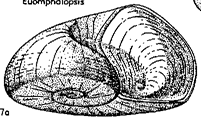
| Palaeos |  |
Gastropoda |
| Mollusca | Macluritoidea |
| Page Back | Unit Up | Clade Up: Gastropoda | Page Next |
| Unit Back | Clade Down: (None) | Glossary | Unit Next |
|
Abbreviated Dendrogram
MOLLUSCA |--ACULIFERA `--CONCHIFERA `==Helcionelloida `--+--Bellerophontoidea `--GASTROPODA (crown group) |==Eogastropoda (paraphyletic or polyphyletic) | |?--Macluritoidea | |?--Euomphaloidea | `--Patellogastropoda `--Orthogastropoda |--Vetigastropoda |--Neritimorpha `--+--Caenogastropoda `--Heterobranchia |--Opisthobranchia `--Pulmonata |
Contents
Index |
Taxa on This Page

Earth History Resources - image South Dakota School of Mines and Technology - Museum of Geology
The Macluritids are a unique but short-lived group of extinct mollusks that include some excellent guide fossils in Ordovician rocks [Moore, et al. 1952, p.302]. They have been variously identified as archaeogastropods, paragastropods, and eogastropods; either ancestral to, or closely related to, the Euomphaloidea, and are limited entirely to the Ordovician, being most common in the early and early-middle part of the period.
 |
|
image © xxxx Knight et
al., 1960 p.I188
|
The Macluritid shell is very distinctive, and nothing at all like the shell of any extant gastropod. One side of the shell is nearly flat, and the opposite side is concave because of the wide umbilicus.
If the umbilicate side is directed downward and the flat side upward, this gives the impression the shell is sinistral or a left-handed spiral, because the aperture when held toward the observer is on the left.
The heavy calcareous operculum tells a different story. The operculum is often preserved as a fossil, both apart from the rest of the shell, and also fitting snugly in the aperture. While some opercula grow concentrically, in the case of Maclurites it is in a spiral. A spiral can be either left or right-handed, and can also be used to establish the direction of the coiling of the shell to which it belongs, regardless of shape. This is because it is opposite that of the rest of the shell. So the spiral of the operculum of a dextral (right-handed) snail is invariably counterclockwise, while that of a sinistral shell is the opposite. From the shape of Macluritid opercula, we know that Macluritids are dextral shells with a depressed (sunken or downward pointing) spire, not left-handed shells with a normal elevated one. The flat side is therefore (logically) the base of the shell [Moore, et al. 1952, p.302].
The Macluritids were almost certainly sedentary, resting in quite water with the base on the seafloor, and living as suspension feeders sweeping up food particles with cilia (or possibly, although much less likely, mucus nets). This was clearly a very successful adaptation, as the group is very abundant in the Ordovician rocks.
This same lifestyle was also adopted independently by the Mimospirida and Euomphaloidea, and so the filter feeding habit continued throughout the Paleozoic (although the Macluritids themselves became extinct at the end of the Ordovician). But whereas the macluritids rested with their right (flat or base) side on the substrate so that the spire is down, the Mimospirid Clisospiridae rested their left side against the substrate so that the spire is upwards. [Linsley and Kier 1984]
The Macluritids were originally considered a superfamily of Archaeogastropods, and according to Knight et al 1954 gave rise to the Euomphaloidea, with which they are usually associated. However on the basis of shell form and inferred water flow patterns, Linsley and Kier 1984 proposed the Class Paragastropoda, including the Pelagiellida, the Mimospirida, the Macluritidae, and tentatively the Euomphaloidea, as untorted (and hence non-Gastropod) molluscs. Runnegar, 1983 suggested a similar phylogenetic scheme, according to which the Macluritoidea and other gastropods independently arose from untorted pelagiellids and subsequently acquired torsion independently. But flow-tank studies by Morris (1991) indicate that the shell morphology of Maclurites would encourage Bernoulli effects and thus facilitate suspension feeding, but only if it was a torted mollusk [Wagner 2001]. And cladistic analyses by Wagner 1999 relate the Macluritoidea to other euomphaloid gastropods. The protoconchs of macluritids, which could help resolve this question, are still unknown.
Macluritoidea: Stratigraphic Range: Ordovician Phylogeny: ?Paragastropoda/Gastropoda/Eogastropoda Euomphalida : Macluritoidea Characteristics: Rather large, $ hyperstrophic shells with radial apertures. $ Aperture rather elongated with angulation at upper surface that is presumed excurrent. $ Base flattened or gently protruding. [Linsley and Kier 1984 p.251] Taxon: Superfamily Macluritoidea Fischer, 1885 Macluritidae : Stratigraphic Range: Ordovician Phylogeny: see Macluritoidea Characteristics: Same as Superfamily. Taxon: Family Macluritidae Fischer, 1885 Genera included: - Palliseria Wilson, 1924; Maclurites Lesueur, 1818; Macluritella Kirk, 1927; Teiichispira Yochelson & Jones, 1958. Notes: The superfamily Macluritoidea includes only the single family Macluritidae (the Onychochilidae are also included under the Macluritoidea by Knight, et al., 1960 but are transferred to the Paragastropoda by Linsley and Kier 1984, Wagner 1999's outgroup analysis also supports the Onychochilidae placement). Less than a dozen genera are known, typified by Maclurites. Most of the shells are large, and all are planispiral or very low conispiral, being either tightly or loosely coiled. |
| Page Back | Page Top | Unit Home | Page Next |
page uploaded 6 March 2003
checked ATW051116
original material by M. Alan Kazlev (Creative Commons)
all other material © original authors or sources